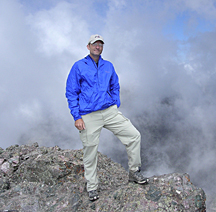- Number 317 |
- August 2, 2010
Alaskan research is a new frontier for ORNL ecologist

Stan Wullschleger
If anything could lure Stan Wullschleger to the frozen reaches of Alaska, he always figured it would be his love of mountaineering. An avid climber who recently reached his goal of scaling all 57 peaks above 14,000 ft in Colorado, Wullschleger admits he had daydreamed about traveling to Alaska in conjunction with his mountaineering hobby, but never thought he would go to conduct research.
“The opportunity that we have now is to lay the foundation for an important global change study in Alaska for the Department of Energy,” said Wullschleger. “A year ago, I never would have thought that was possible.”
Wullschleger is leading a team of researchers from DOE's Oak Ridge National Laboratory, in collaboration with partners in Alaska and Los Alamos and Brookhaven national laboratories, to better understand the vulnerability of high latitude ecosystems to climate change. Arctic ecosystems are among the largest and coldest of all biomes and are viewed to be especially sensitive to rising temperatures associated with global warming.
“The release of carbon stored in permafrost and northward expansion of woody shrubs represent important feedbacks on climate, both of which have the potential to cause rapid changes in the earth system,” said Wullschleger.
The first step for Wullschleger and his colleagues is to develop new approaches to experimentally warming ecosystems in a controlled manner. Current aboveground and belowground heating approaches are limited and may not be suitable for eventual use in a fully replicated experiment. Using new technologies to simulate the effects of global warming would enable the researchers to gauge how higher temperatures could influence arctic ecosystems.
“The current prototyping activity that we’re doing in Barrow and Fairbanks has to do with testing technology and laying a foundation for a global warming study somewhere in Alaska,” said Wullschleger. “Given the potential impact of climate change on these sensitive ecosystems, we want to develop an ambitious plan for this activity.”
The research, sponsored by DOE’s Office of Biological and Environmental Research, involves the design and simulation of prototypes to warm field plots up to 20 meters in diameter. High-performance computers will aid in the simulation process. Researchers will also need to tackle challenges of how best to provide the energy needs of such a large experiment. By studying the effect of warming on permafrost degradation, ecosystem dynamics and landscape processes, the team hopes to gain a clearer understanding of land-atmosphere feedbacks on climate.
Although Wullschleger is a newcomer to Alaska, he is no stranger to climate change research. Since his arrival at ORNL in 1990, Wullschleger has been delving into global change questions for ORNL’s Environmental Sciences Division for 20 years.
“The research I have historically done has been on the environmental controls on plant growth and ecosystem function,” said Wullschleger. “Climate change research is a natural fit for my interests and understanding how the environment impacts plants, soils and ecosystems.”
Wullschleger holds a dual affiliation at ORNL’s Environmental Sciences Division and Climate Change Science Institute. The challenges of conducting research in unfamiliar terrain, he says, are eased by the available resources at national labs.
“The work we’re doing for the Department of Energy is made considerably easier because of the breadth of expertise we have at Oak Ridge and the other national labs,” said Wullschleger.—Morgan McCorkleSubmitted by DOE's Oak Ridge National Laboratory
